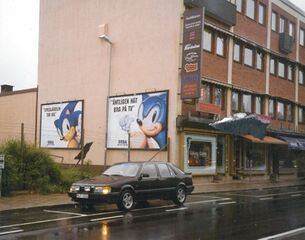Difference between revisions of "History of Sega in Sweden"
From Sega Retro
| Line 28: | Line 28: | ||
In 1996, TCI's technology group got the rights to distribute [[Sega Channel]] in the Scandinavian countries, but we do not know anything about launching this service in Sweden. | In 1996, TCI's technology group got the rights to distribute [[Sega Channel]] in the Scandinavian countries, but we do not know anything about launching this service in Sweden. | ||
| − | Brio also distributed [[Sega Saturn]] and [[Sega Dreamcast]]. Dreamcast Internet was available from December 2000. | + | Brio also distributed [[Sega Saturn]] and [[Sega Dreamcast]]. Dreamcast Internet was available by BT from December 2000.<ref>https://spong.com/press_release/773/Sega-Dreamcast-Continues-European-Online-Push</ref> |
In 2003 in the Scandinavian countries the company [[Pan Vision]] became the distributor of Sega.<ref>https://web.archive.org/web/20030601082124/http://www.panvision.com:80/o.o.i.s/107</ref> In 2014, the company [[Koch Media]] became the sale of games as in most countries of Western Europe.<ref>https://www.mcvuk.com/business/koch-media-will-distribute-sega-games-in-nordic</ref> | In 2003 in the Scandinavian countries the company [[Pan Vision]] became the distributor of Sega.<ref>https://web.archive.org/web/20030601082124/http://www.panvision.com:80/o.o.i.s/107</ref> In 2014, the company [[Koch Media]] became the sale of games as in most countries of Western Europe.<ref>https://www.mcvuk.com/business/koch-media-will-distribute-sega-games-in-nordic</ref> | ||
Revision as of 06:41, 4 December 2022
This teeny-tiny article needs some work. You can help us by expanding it.

|
| History of Sega in Sweden |
|---|
| Official Sega distributor(s): Dennis Bergström Elektronik (1987-1990), Brio (1990-2002), Pan Vision (2003-2014), Koch Media (2014-present) |
In the 70s Sweden was one of the countries where Sega imported its game machines.[1]
Dennis Bergström Elektronik released the Sega Master System in Sweden in 1987. The company founded Sega Klubben, the Sega Posten magazine and a telephone line called Sega Hot Line.[2] As early Sega Master System games did not include Swedish in the instructions Dennis Bergström included separate Swedish language instruction inserts for many games. Later European releases would include Swedish as standard.
In the spring of 1990, the distribution of consoles was taken care of by Brio, who continued the sale of the Master System. The operations were then transferred to its wholly owned subsidiary PlayMix[3], and Anders Hallberg[4] apointed as its CEO. Other key persons for Sega in Sweden were, PlayMix Marketing Manager Stefan Lampinen[5] and Product Manager Roger Jönsson[4]. Sega Posten was replaced by Sega Official Software News and Sega Newsletter dedicated for traders was created.
The Sega Mega Drive was presented for the first time to Swedish consumers in the spring of 1990 at the BRIO's Toy Fair, with subsequent demonstrations in other fairs and events, as the Saturday, September 27th 1990 demonstration at the Gallerian Shopping Center[6] in Stockholm. Around 22-26 October Mega Drive appeared in other stores. About 8,000 consoles were sold in 1990 alone. The year 1991 was quite a breakthrough when the first part of Sonic was released (August 22). Brio started a lot of advertising for the new game selling 40,000 copies which was very good compared to the other games that sold around 15,000 copies. Brio released Master System II and Game Gear in this year.
In 1992, in addition to replacing Sega Official Software News with Sega Force magazine, advertising began with the slogan Här Börjar Äventyret. On November 24, Sonic 2 had its premiere, which once again recorded good sales results at the level of 60,000 copies sold.
On May 27, 1993, the first Mega CD model I was released in Sweden, and on August 10 of the same year, the Mega Drive II was released. Another advertising campaign was launched, entitled Beat Us.If You Can.
There were also special games for Sweden such as Elitserien 95 which was a rebranding of NHL 95 with teams swapped for the Swedish hockey team. The game turned out to be quite a success and was number one on sale during the 1994 holiday season. All in all, 37,000 copies were sold. There was even a successor the following year called Elitserien 96.
Mega Drive was distributed in Sweden in the amount of 150,000 copies and the most popular games were Sonic and Hockey.[7][8]
With the defeat of the Mega Drive 32X console, Brio formed the Sega Power Club and Sega Force was replaced by Sega Power Magazine.[9]
In 1996, TCI's technology group got the rights to distribute Sega Channel in the Scandinavian countries, but we do not know anything about launching this service in Sweden.
Brio also distributed Sega Saturn and Sega Dreamcast. Dreamcast Internet was available by BT from December 2000.[10]
In 2003 in the Scandinavian countries the company Pan Vision became the distributor of Sega.[11] In 2014, the company Koch Media became the sale of games as in most countries of Western Europe.[12]
References
- ↑ File:Sega_Company_Profile_1970.pdf
- ↑ https://martinlindell.com/2018/02/04/sega-klubben-och-dr-roffe/
- ↑ File:HistoriemOmSega1 SE Book.pdf, page 65
- ↑ 4.0 4.1 File:HistoriemOmSega1 SE Book.pdf, page 67
- ↑ File:HistoriemOmSega1 SE Book.pdf, page 66
- ↑ https://sv.wikipedia.org/wiki/Gallerian
- ↑ https://martinlindell.com/historien-om-sega/
- ↑ Historien om Sega: Hur en blå igelkott och hockeyspel tog Sverige med storm
- ↑ https://martinlindell.com/2018/02/04/sega-klubben-och-dr-roffe/
- ↑ https://spong.com/press_release/773/Sega-Dreamcast-Continues-European-Online-Push
- ↑ https://web.archive.org/web/20030601082124/http://www.panvision.com:80/o.o.i.s/107
- ↑ https://www.mcvuk.com/business/koch-media-will-distribute-sega-games-in-nordic